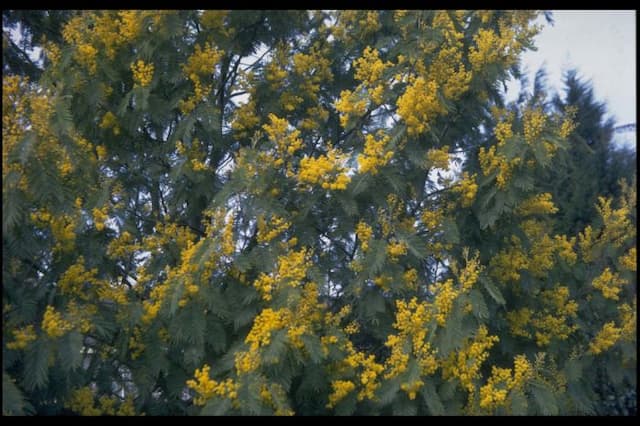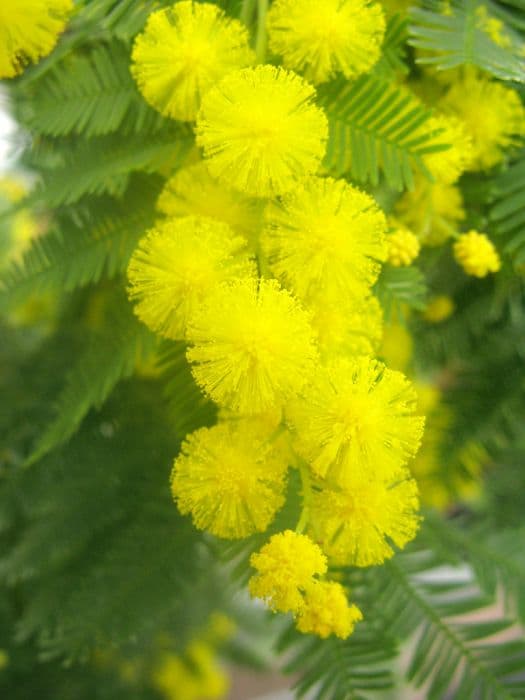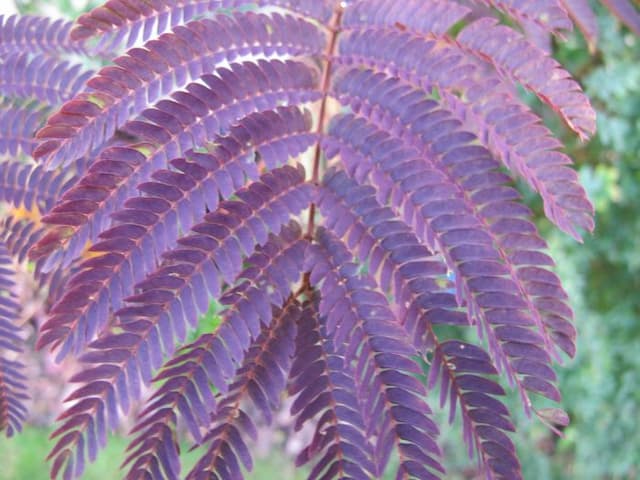Goat's Rue Galega officinalis 'Alba'

ABOUT
Galega officinalis 'Alba', commonly known as goat's rue, is a perennial plant with a striking appearance. It boasts upright stems that are adorned with pinnate leaves, each leaf is composed of multiple delicate leaflets. The leaflets are oval-shaped, with a soft green color that adds a lush look to the foliage. During flowering season, goat's rue reveals its charm with racemes of pea-like flowers that are pure white, offering a gentle yet bright aspect to the plant's overall aesthetic. The flowers are clustered together, creating a spike-like effect that is both elegant and eye-catching, a contrast to the verdant leaves. The overall shape and structure of goat's rue lend it a bushy, herbaceous look that can add a cottage garden feel to any planting area. Its blooms attract bees and butterflies, adding to the lively display in its growing season.
About this plant
 Names
NamesFamily
Fabaceae.
Synonyms
Goat's Rue, French Lilac, Italian Fitch, Professor-weed.
Common names
Galega alba, Galega bicolor, Galega officinalis var. alba.
 Toxicity
ToxicityTo humans
Goat's rue is known to be toxic to humans when ingested. Its toxic components can interfere with normal cellular processes, particularly in the liver. Symptoms of goat's rue poisoning may include nausea, vomiting, diarrhea, abdominal pain, confusion, weakness, and, in severe cases, it might lead to organ damage or failure if consumed in large amounts. Care should always be taken to avoid ingesting any part of this plant.
To pets
Goat's rue is also toxic to pets, including dogs, cats, and horses. Symptoms of poisoning in pets are similar to those in humans and can include vomiting, diarrhea, lethargy, and more seriously, it may cause liver damage or failure. If a pet ingests goat's rue, immediate veterinary attention is recommended to manage the symptoms and prevent more serious health consequences.
 Characteristics
CharacteristicsLife cycle
Perennials
Foliage type
Deciduous
Color of leaves
Green
Flower color
White
Height
4 feet (1.22 meters)
Spread
2 feet (0.61 meters)
Plant type
Herb
Hardiness zones
4
Native area
Europe
Benefits
 General Benefits
General Benefits- Attracts pollinators: Galega officinalis 'Alba', commonly known as white goat's rue, is attractive to bees, butterflies, and other beneficial insects, aiding pollination in the garden.
- Drought-tolerant: Once established, white goat's rue is fairly drought-resistant, requiring minimal watering and reducing the need for irrigation.
- Aesthetic appeal: With its delicate white flowers, white goat's rue adds beauty and contrast to garden settings and is suitable for cottage gardens and borders.
- Nitrogen fixation: As a legume, white goat's rue has the ability to fix atmospheric nitrogen, thus enriching the soil and reducing the need for synthetic fertilizers.
- Easy to grow: This plant is generally hardy and easy to cultivate, making it a good choice for novice gardeners or those with less time to devote to maintenance.
- Erosion control: The root system of white goat's rue can help stabilize soil, aid in erosion control, and improve soil structure over time.
 Medical Properties
Medical Properties- Diuretic: Galega officinalis 'Alba', also known as French lilac or goat's rue, has been traditionally used as a diuretic, helping to increase the excretion of water from the body.
- Galactogogue: The herb is also known for its capacity to enhance milk production in lactating women.
- Antidiabetic: French lilac contains galegine, which has been investigated for its potential to lower blood sugar, a property that historically contributed to the development of metformin, a medication for diabetes.
 Air-purifying Qualities
Air-purifying QualitiesThis plant is not specifically known for air purifying qualities.
 Other Uses
Other Uses- Galega officinalis 'Alba', commonly known as Goat's Rue, has been traditionally used as a forage plant for livestock, providing a nutritious food source.
- The plant can be used as a cover crop, improving soil quality and providing weed control in agricultural settings.
- Goat's Rue is used in companion planting to enhance the growth and health of other plants by attracting beneficial insects that prey on pests.
- The flowers of Goat's Rue can be a valuable source of nectar for bees and other pollinators, supporting local ecosystems.
- In ornamental gardens, the white flowers of 'Alba' can be used to create contrast and visual interest among other plants.
- Using Goat's Rue in a mixed hedgerow can provide habitat and food for wildlife, increasing biodiversity in garden landscapes.
- The plant's ability to fix nitrogen in the soil can be utilized in crop rotation systems to naturally replenish soil nutrients.
- Goat's Rue has been used in natural dye production, where different parts of the plant can yield varying hues.
- Dried stems and flowers of the plant can be included in potpourri mixes for a natural, subtle fragrance in homes.
- The robust growth habit of Goat's Rue can be harnessed to stabilize soil and prevent erosion in vulnerable areas.
Interesting Facts
 Feng Shui
Feng ShuiThe Goat's Rue is not used in Feng Shui practice.
 Zodiac Sign Compitability
Zodiac Sign CompitabilityThe Goat's Rue is not used in astrology practice.
 Plant Symbolism
Plant Symbolism- Healing: Galega officinalis 'Alba', commonly known as Goat's Rue, has historical uses in traditional medicine, symbolizing the plant’s connection with healing and therapeutic properties.
- Improvement: The plant was believed to stimulate milk production in goats, hence its name, symbolizing an improvement or enhancement of natural processes.
- Protection: Goat's Rue has been thought to offer protection against evil and misfortune due to its medicinal qualities, being used to ward off plagues and diseases in folklore.
 Water
WaterGoat's rue requires regular watering to maintain moist soil, especially during dry periods. It should be watered thoroughly, allowing the water to penetrate deep into the soil, which encourages deep root growth. The frequency of watering should be adjusted depending on the weather and soil conditions, but generally, an inch of water per week is a good starting point. However, it is important not to overwater the plant, as this can lead to root rot. During the growing season, you might water the plant once or twice a week, making sure to adjust if there is rainfall.
 Light
LightGoat's rue thrives in full sun to partial shade. The ideal spot for this plant is an area that receives at least 6 hours of direct sunlight each day, though it can tolerate some shade, especially in hotter climates. The plant will produce the most blossoms when it is placed in a spot with ample sunlight.
 Temperature
TemperatureGoat's rue prefers temperate conditions and can generally tolerate temperatures between 50°F and 85°F. It is hardy to USDA zones 4 through 8, meaning it can withstand minimum temperatures ranging from -30°F to 20°F. The ideal temperature for growing goat's rue lies within the range of 60°F to 70°F.
 Pruning
PruningPruning goat's rue is necessary to encourage bushier growth and more blooms. It should be pruned in early spring, cutting back the previous year's growth to leave only a few inches of stem. Additional light pruning can be done after the plant flowers to remove spent blooms and encourage a second flowering. Pruning can be done annually or as needed to maintain the desired shape and size.
 Cleaning
CleaningAs needed
 Soil
SoilGoat's Rue requires well-draining soil with a pH ranging from 6.0 to 7.0. A mix of loamy soil, peat, and sand is ideal to ensure proper drainage and nutrient retention. Adding organic matter like compost can also encourage healthy growth.
 Repotting
RepottingGoat's Rue does not typically require frequent repotting. It's a hardy perennial and can be repotted every 2-3 years or as needed when the plant outgrows its current container or the soil becomes depleted.
 Humidity & Misting
Humidity & MistingGoat's Rue thrives in average humidity conditions. There's no specific need for high humidity; ambient outdoor humidity levels are generally sufficient for this plant.
 Suitable locations
Suitable locationsIndoor
Ensure bright light and well-draining soil.
Outdoor
Plant in sun or part shade, enrich soil, water regularly.
Hardiness zone
3-8 USDA
 Life cycle
Life cycleThe common name for Galega officinalis 'Alba' is White Goat's Rue. The life of this plant begins as a seed, which upon germination in the spring, produces small seedlings with a pair of initial leaves (cotyledons). As the seedlings grow, they develop a rosette of pinnate leaves at the base and an upright stem. During late spring to early summer, the plant enters the flowering stage, displaying numerous small, white pea-like flowers arranged on an erect spike. After pollination, typically by bees, the flowers develop into seed pods that eventually dry and release seeds for the next generation. White Goat's Rue is a hardy perennial, and once mature, it will die back to the root system in late autumn to survive the winter and then re-sprout the following spring, continuing its life cycle.
 Propogation
PropogationPropogation time
Spring to Summer
For Goat's Rue (Galega officinalis 'Alba'), the most popular method of propagation is by seed sowing. Seeds can be started indoors before the last frost by sowing them in a tray filled with a well-draining seed starting mix. Press the seeds gently into the soil but do not cover them deeply, as they require light for germination. Keep the soil moist, and at a temperature of around 70°F (21°C), germination should occur within 2 to 4 weeks. Once seedlings have grown large enough to handle and the danger of frost has passed, they can be transplanted outdoors into a sunny location with well-drained soil. It is advisable to harden off the seedlings by gradually exposing them to outdoor conditions over a week before planting them out.









